If you’re looking for ways to extend your company, staff augmentation might help you to deal with it. This business practice not only helps with bridging different skill gaps but also saves you money and energy.
I’ve been managing operational processes for IT companies for 15 years and have seen many challenges that tech companies face throughout their development. The team expansion process is the hardest one to address. Thus, I’ve decided to write this article to hack staff augmentation for everyone looking to adopt it in the future. I will also dwell on IT staff augmentation prospects, types of staffing providers and share the best practices for choosing the right engagement model for your tech business.
What is Staff Augmentation?
Staff augmentation is a business strategy used to supplement the existing team with qualified professionals in the most efficient and time-saving way. Some people also call it “resource augmentation” or “business augmentation”. To put it simply, this is when you need to find a few more hands on deck for your project, plus save time and costs on employee hiring, onboarding, and maintenance.
Some people consider staff augmentation an umbrella term for outsourcing and software development office establishment, while others believe it’s another name for outstaffing. So long as they argue about what is staff augmentation, I believe that it’s a related term to outstaffing when it comes to IT.
An example of IT team augmentation is the healthcare project in telemedicine by the University of Pittsburgh Medical Center. With the help of staffing services, the university managed to grow its team and go from “zero to 100 in telemedicine overnight”.
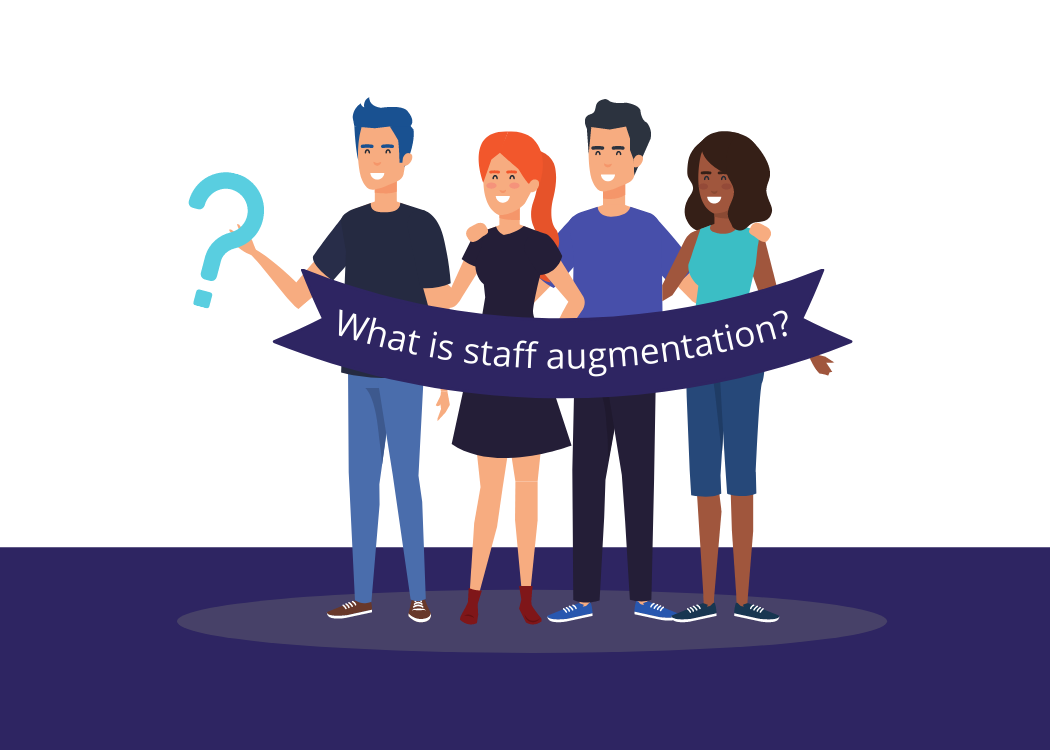
IT Staff Augmentation and Why It’s so in Demand
IT executives resort to staff augmentation for IT when they realize that their onsite team no longer satisfies all the needs of their enterprise. It happens if a company grows, launches bigger projects, and has to deal with several important tasks at once. In this case, in-house developers might sometimes fail to meet all the deadlines and need external help in the shortest time. That’s when software outsourcing usually comes in handy. But, if you need to get more control over task completion, an IT staff augmentation company is more helpful.
However, 2022 offers additional challenges. Great Resignation continues, while the world experiences an economic downturn. People across different industries quit their jobs at record rates, and IT is no exception. According to the U.S. Bureau of Labor Statistics, 4.5 million Americans resigned in November 2021 alone. This hardship is accompanied by rising inflation, fears of recession, and labor shortages.
Due to the loss of in-house specialists, companies turn to temporary solutions for filling talent gaps. I believe that employee turnover and the lack of software developers will continue to drive demand for epic IT staff augmentation. It’s forecasted that the global staff augmentation services market will grow at a CAGR of 3.53% between 2021 and 2025, reaching a total incremental spend of $81.87 billion.
Keep reading to discover the most recent staff augmentation trends in the IT sector.
IT Staff Augmentation Trends
Focus on Advanced IT Skills
IT staff augmentation has become an important stage in expanding tech companies because it lets them find even the most sought-after engineering skills. Nowadays, tech enterprises are looking to integrate advanced technologies, such as AI, ML, IPA, blockchain, cybersecurity, cloud and scientific computing. In the coming future, professionals in these fields will be in huge demand which will definitely reshape clients’ staffing requests.
Staffing Automation
Coming out of lockdowns, we saw a huge acceleration in remote work and automation trends. Clients now expect fast and convenient solutions from IT staff augmentation providers. Therefore, it is worth investing in virtual tools for video conferencing, tracking and messaging systems, as well as skill testing tools to sort the best software engineers from the rest.
Global Market Accessibility
Sometimes, regional partners don’t have enough expertise and capabilities to offer the best talents. That’s why IT staffing trends also include engaging distributed workforce around the globe. The pandemic taught us how to manage remote teams, so today companies are ready to tap into a much larger global talent pool to find suitable and rare programmers.
Types of Staff Augmentation Providers
To satisfy the needs of different clients, staff augmentation has transformed into a huge industry with various providers. The most common of them are:
Traditional staffing providers
This is an agency that is also called a “commercial/generalist staffing provider”. Its primary function is to augment your team with the needed expertise in non-critical projects but not the employees with specific skill sets. For example, if you’re a CEO of an IT product company, you may use the services of such staffing vendors to find a good data entry specialist.
Boutique staffing firms
Boutique staffing usually refers to small staffing agencies that can fill even the hardest roles in your company such as Senior Architect. Such a vendor provides highly customized services and values quality over quantity. That is why you need to pay a fortune for their assistance sometimes.
Staffing platforms
These platforms which are also called “human clouds” provide staff augmentation services and connect potential employees and employers. They are divided into gig and on-demand platforms. The only difference between them is that gig platforms do not guarantee that you will receive professional employees, while on-demand platforms try to provide only curated, interviewed, and vetted talents.
Recruitment agencies
An IT recruitment agency is a staffing provider that hires employees for both critical and non-critical projects of the client. They can perform various kinds of staffing services, including e-commerce, AI, IoT, healthcare IT recruiting, and more. Such providers receive a recruitment fee if they find a suitable candidate for a job. As a result, a client receives a fully dedicated development team and the ability to manage it with no intermediaries. Partnership with an IT recruitment services company opens doors for many other advantages, such as enhanced employer brand, secured IP rights, and complete control over business expenses.
This is what Sift did with the help of Alcor! It’s a US-based product software company that prevents cybercrimes by developing online fraud detection solutions. Having 180+ employees worldwide, a client decided to expand further and assemble its own software team in Eastern Europe. Alcor engaged 10 IT researchers, 3 IT recruiters, and an account manager to work on Sift’s vacancies and provide full-cycle IT recruitment services. Additionally, our team took care of shooting a video with a Hiring Manager and launched a social media campaign for its promotion. These activities sped up hiring and improved the image of Sift on the market. During our fruitful cooperation, 20+ talented software developers joined Sift!
Pros and Cons of Staff Augmentation Services
Before you get your feet wet with staff augmentation, you need to get the full picture of such an outstaffing model. Thus, I’ve come up with all the pros and cons of this team extension business practice. Let’s start with the advantages.
-
Expertise
With staff augmentation, you receive access to all the skill sets that your company lacks. If you need a QA engineer to test your new software but don’t want to hire this person full-time, the staff augmentation model has got you covered.
-
Quick personnel scaling
Staff augmentation firms can help you find the right talents fast and cut the time that you would have spent on hiring and management of these very talents yourself. For example, if you need to find a couple of middle engineers for a project, you can quickly bridge this gap without the hustle and bustle.
-
Flexibility
Given the popularity of staffing providers, they never have difficulty with finding the specialist your company is missing. So, if you identify talent insufficiencies among your existing workers, an IT staff augmentation team will help you replace them. Once you’ve done that and benefitted from the services of your augmented employees, you may easily fire them.
-
Cost savings
When you hire full-time in-house employees, you need to spend a lot of money on their training, procurements, and maintenance. With staff augmentation, you don’t have to do this. Your outstaffed personnel works from home or a provider’s office, so you save your resources substantially.
Even though staff augmentation may seem a nice solution to quickly address and fill the skill gaps in your company, it has some downsides you need to be aware of, for example:
-
Lack of dedication
Your temporary employees know that your project will soon be done, just like their commitment to it. That is why they don’t care much about the well-being of your company in the future. For this reason, permanent workers (both onsite and remote) are better.
-
Additional long-term costs
Staff augmentation is great if we’re talking about a short-term perspective and project outsourcing. But, if you like the results of augmented employees and want to retain them, it will cost you more. This is because you either pay a service fee to the staffing provider, a commission to the staffing platform, or a buy-out fee for an augmented worker. Thus, full-time on-premises workers are cheaper than staff-augmented ones in the long run.
-
Onboarding time
Staff augmenting is quick in terms of team scaling, and you don’t worry about recruiting and management. However, you still need to allocate some time to onboard your new team player to help them deal with the tasks more efficiently.
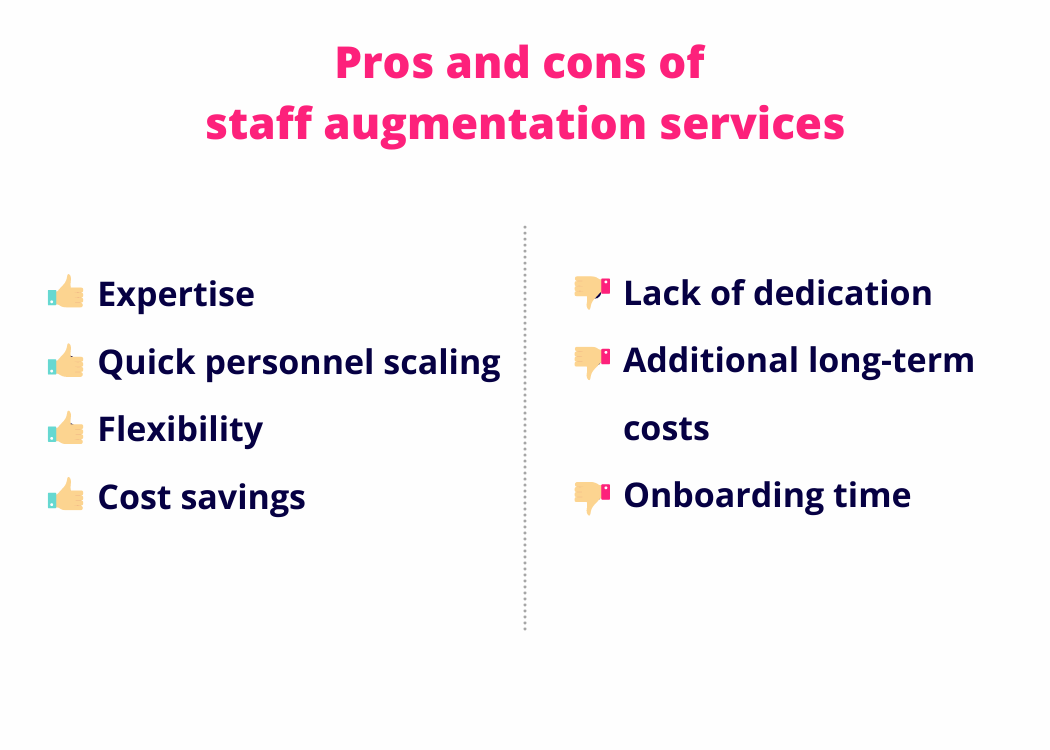
Staff Augmentation for IT:
the Interim Stage of Business Expanding?
IT staff augmentation services are beneficial because tech companies may now hire the top talents not only in their home country but abroad – remote work has made this a reality. Besides, finding developers online is stress-free and saves tons of costs, so IT business leaders resort to this service often.
Note that IT staff extension solutions work best as a transition stage of team upgrading. This process starts with hiring a couple of freelancers, making sure it’s safe, cost-saving, and convenient to work with them, and then stepping freelancing up with outsourcing.
At this point, business executives delegate the whole software development projects to outsourcing agencies. When the necessary task is accomplished, IT companies want to have results like this all the time and opt for outstaffing. They receive the right talent who works for them on a project-by-project basis but find it expensive to pay the service fee to the provider.
This is when top managers go all-in for their own offshore development team. To assemble it properly, they choose the right location by comparing the top places for remote work. Then, it’s time for them to choose regions like Eastern Europe because of the large talent pool (1 million software developers), profound expertise, and affordable remunerations. After that, business leaders compare the top providers in this location and stick with those who can provide seamless tech recruitment. To build a sustained presence in the offshore market an IT company can go further and establish its branded development office with full-cycle operational support.
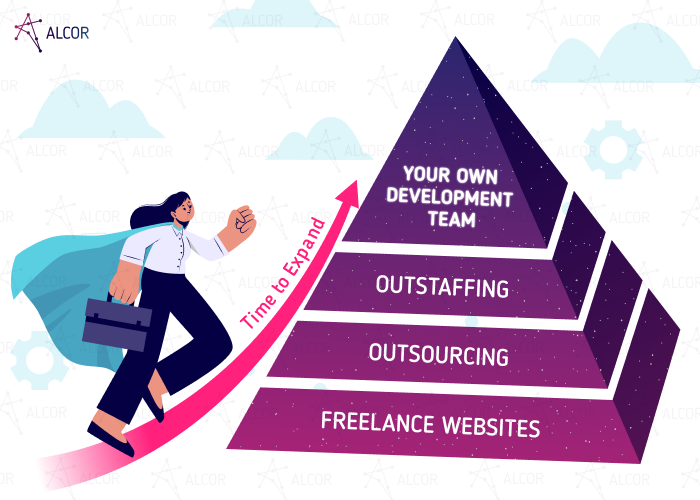
Staff Augmentation vs. Managed Services
Managed services are also called consulting assistance in specific business tasks. Managed services providers work side-by-side with a client but don’t overtake full control over the project. They help you manage your tasks more strategically while keeping long-term results in mind.
In contrast to managed services, staff augmentation leaves you completely in charge of all the operations. You are still the manager of your team’s success and have to oversee your new employees’ performance yourself.
Staff Augmentation vs. Software Outsourcing
Software outsourcing is a related term to staff augmentation but these are not the same concepts. When you outsource business processes, you delegate control over a project to third-party vendors. In this way, you get rid of management once and for all.
Compared to the IT outsourcing models, staff augmentation lets you address the hiring challenges if you feel the candidate is unsuitable and monitor the progress of your new team. The reasons for outsourcing IT services, though, are quite similar to the ones for staff augmentation.
Staff augmentation vs. Dedicated teams
If you are interested in setting up a dedicated team, you’ll receive loyal employees that will supplement your existing team and be focused solely on your project. This way you invest your resources in long-term success and build a relationship with the people who work for you.
Staff augmentation offers you something similar, right? But, the difference lies in management. While dedicated teams are usually supervised by a vendor, the augmented staff recognizes you as their main manager.
Staff Augmentation vs. R&D Center
Some people confuse the terms “dedicated team” and “R&D center” and think it’s the same thing. However, setting up a software R&D center presupposes receiving recruitment process outsourcing services.
What does it mean? First off, you choose a reliable vendor who recruits a full-fledged team. Having 10 years of market experience, Alcor provides tech enterprises with IT recruitment services in Poland and Romania. We have 40+ tech recruiters on board who handle hiring consultations, candidate sourcing, screening, interviewing and job offer preparation. On average it takes us to send 8 CVs to a client to get to 1 accepted offer.
When a development team is all set, Alcor can take care of other BPO services upon request. These include payroll, equipment procurement, legal support, office lease and other back-office tasks. All the services together make up a comprehensive offshore development center. A client gets a software team abroad that not only develops and supports their product but cares about its future.
An example of applying this engagement model is People.ai, a software product company that provides B2B sales solutions through the AI-powered platform. The company wanted to expand its engineering team abroad and maintain full control over costs and software development. Therefore, they decided to hire programmers in Eastern Europe with Alcor! Our IT researchers and recruiters provided the client with candidates with a proven track record, weekly reports, continuous advice and support. By using premium HR resources and an internal database of over 200,000 verified developers, we managed to hire 25 engineers with rare skills. Our team also took care of other back-office services, such as accounting and legal compliance, that made up a fully backed-up R&D center in only 4 weeks. Now People.ai has a unicorn status and employs 125+ people around the world.
Staff augmentation cannot boast of something like that because you receive a worker or a team of workers but then lose them after the contract ends.
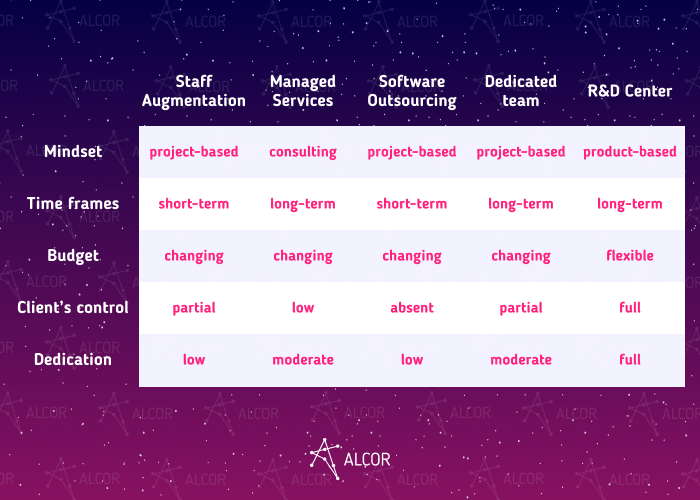
4 IT Staff Augmentation Tips for Decision Making
How can a business leader choose the most beneficial engagement model in such a variety of options? Here are 4 questions you should ask yourself to make a final decision.
1. Do you need project scalability or operational scalability?
Discussed models offer different scaling alternatives. For instance, IT outsourcing or staff augmentation solution is a good choice when you need extra resources for specific projects. Contrary to that, managed services and an R&D center with back-office support offer operational scalability and long-lasting assistance as your business grows.
2. Do you look for a short-term or long-term solution?
Software outsourcing and staff augmentation offer short-term results to tech companies. On the other hand, a dedicated team model is suitable for long-term evolving projects, as well as managed services and an R&D center.
3. Which amount of control do you expect to maintain?
Pick an R&D or a dedicated team model to retain full control over the software development process. These models provide the clients with the highest level of independence. Thus, they also offer flexibility and an option to integrate constant changes. In contrast, by getting IT services from software outsourcing providers, tech companies delegate their core business activities and have little impact on the final product.
4. Do you want to have a determined project budget?
Hiring your own development team to work in an R&D hub is the best decision to receive pricing transparency. Other models are quite ambiguous in this matter. As I have already mentioned, staff augmentation presupposes buy-out fees in a long-term perspective. As regards outsourcing providers, they tend to charge extra money for additional adjustments and fixes. That makes the final price very difficult to predict. Other intermediaries could charge big upfront investments or merge the provider’s fee and the remuneration of the software team into one invoice. Therefore, only in an R&D center with your own employees you will remain a boss, set your own rules, and control all the costs.
Final Thoughts
Whether to implement staff augmentation or not is up to you. Given the benefits that this team extension model offers, such as expertise, quick team scaling, flexibility, and cost savings, this might be a good choice. But, before you make any hasty decisions, don’t forget about the downsides of this business practice such as decreased dedication, onboarding time, and additional long-term costs.
If you feel that staff augmentation is not enough, you may weigh the pros and cons of using an IT staffing agency, managed services, IT outsourcing, and dedicated teams. Smart executives choose a business-expanding solution that will help them achieve their staffing goals in the shortest time, save substantial costs, and build rapport with their new team. So far, only an offshore development office with your own software team has managed to reach all of these goals.
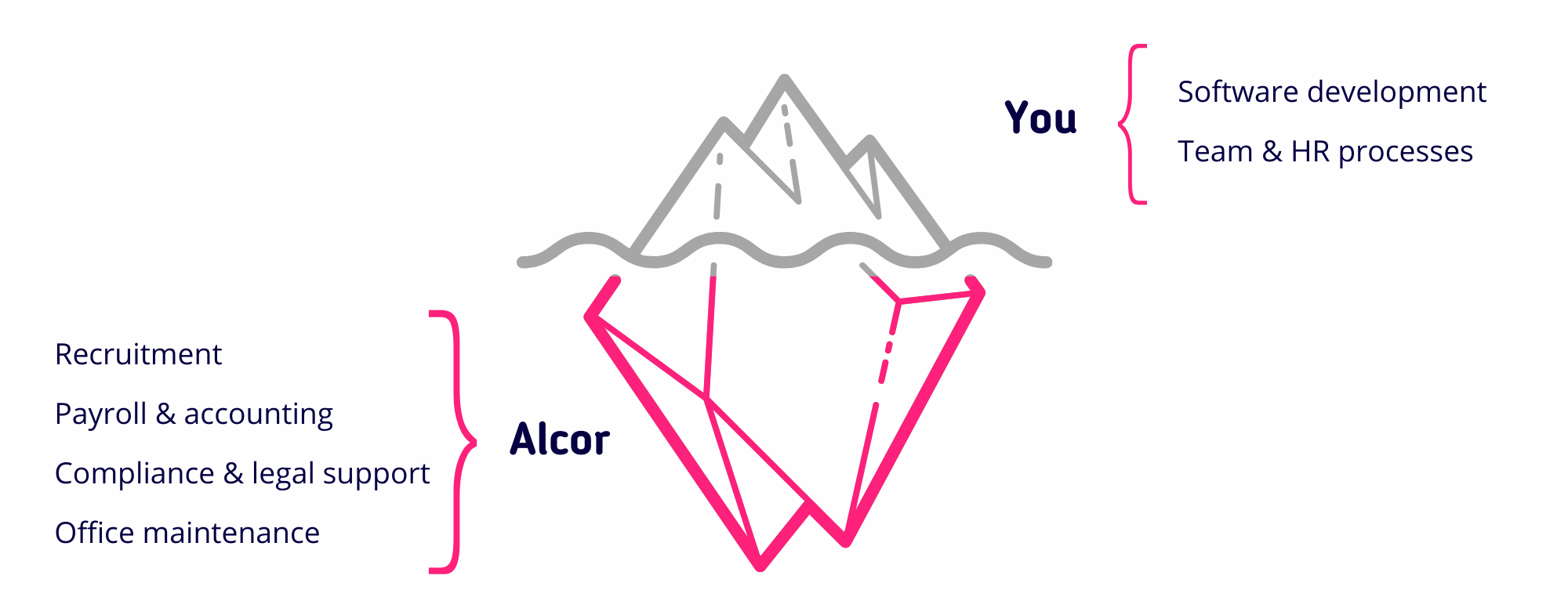
FAQ
???? 1. What is IT staff augmentation?
Staff augmentation implies engaging software developers who are officially employed by another company. This strategy is aimed at filling temporary skill gaps by integrating such external programmers into your in-house team.
???? 2. What are the advantages of a staff augmentation solution?
Benefits of staff augmentation include quick personnel and project scaling, flexibility, cost reduction, and the possibility to fill expertise gaps.
???? 3. Are there any disadvantages of the IT staff augmentation team?
Among the disadvantages of the staff augmentation model are such aspects as lack of dedication from the external development team, additional long-term expenses and onboarding time.
???? 4. Are there any alternatives that are better than IT staff augmentation?
Launching an R&D center with full-cycle IT recruitment services is a winning solution for tech companies with ambitious growth plans. This long-term model offers full control over software development, team management, and business expenses. You will receive committed engineers, secure IP rights and promote your employer brand.
